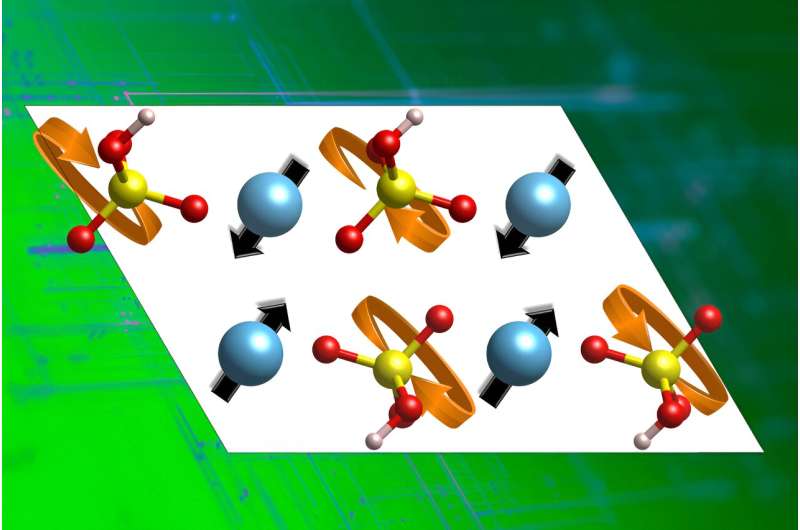
JULY 23, 2024 by David L. Chandler, Massachusetts Institute of Technology
Collected at: https://techxplore.com/news/2024-07-proton-materials-enable-green-energy.html
As the name suggests, most electronic devices today work through the movement of electrons. But materials that can efficiently conduct protons—the nucleus of the hydrogen atom—could be key to a number of important technologies for combating global climate change.
Most proton-conducting inorganic materials available now require undesirably high temperatures to achieve sufficiently high conductivity. However, lower-temperature alternatives could enable a variety of technologies, such as more efficient and durable fuel cells to produce clean electricity from hydrogen, electrolyzers to make clean fuels such as hydrogen for transportation, solid-state proton batteries, and even new kinds of computing devices based on iono-electronic effects.
In order to advance the development of proton conductors, MIT engineers have identified certain traits of materials that give rise to fast proton conduction. Using those traits quantitatively, the team identified a half-dozen new candidates that show promise as fast proton conductors. Simulations suggest these candidates will perform far better than existing materials, although they still need to be conformed experimentally. In addition to uncovering potential new materials, the research also provides a deeper understanding at the atomic level of how such materials work.
The new findings are described in the journal Energy and Environmental Sciences, in a paper by MIT professors Bilge Yildiz and Ju Li, postdocs Pjotrs Zguns and Konstantin Klyukin, and their collaborator Sossina Haile and her students from Northwestern University. Yildiz is the Breene M. Kerr Professor in the departments of Nuclear Science and Engineering, and Materials Science and Engineering.
“Proton conductors are needed in clean energy conversion applications such as fuel cells, where we use hydrogen to produce carbon dioxide-free electricity,” Yildiz explains. “We want to do this process efficiently, and therefore we need materials that can transport protons very fast through such devices.”
Present methods of producing hydrogen, for example steam methane reforming, emit a great deal of carbon dioxide. “One way to eliminate that is to electrochemically produce hydrogen from water vapor, and that needs very good proton conductors,” Yildiz says. Production of other important industrial chemicals and potential fuels, such as ammonia, can also be carried out through efficient electrochemical systems that require good proton conductors.
But most inorganic materials that conduct protons can only operate at temperatures of 200 to 600 degrees Celsius (roughly 450 to 1,100 Fahrenheit), or even higher. Such temperatures require energy to maintain and can cause degradation of materials.
“Going to higher temperatures is not desirable because that makes the whole system more challenging, and the material durability becomes an issue,” Yildiz says. “There is no good inorganic proton conductor at room temperature.”
Today, the only known room-temperature proton conductor is a polymeric material that is not practical for applications in computing devices because it can’t easily be scaled down to the nanometer regime, she says.
To tackle the problem, the team first needed to develop a basic and quantitative understanding of exactly how proton conduction works, taking a class of inorganic proton conductors, called solid acids. “One has to first understand what governs proton conduction in these inorganic compounds,” she says. While looking at the materials’ atomic configurations, the researchers identified a pair of characteristics that directly relates to the materials’ proton-carrying potential.
As Yildiz explains, proton conduction first involves a proton “hopping from a donor oxygen atom to an acceptor oxygen. And then the environment has to reorganize and take the accepted proton away, so that it can hop to another neighboring acceptor, enabling long-range proton diffusion.”
This process happens in many inorganic solids, she says. Figuring out how that last part works—how the atomic lattice gets reorganized to take the accepted proton away from the original donor atom—was a key part of this research, she says.
The researchers used computer simulations to study a class of materials called solid acids that become good proton conductors above 200 degrees Celsius. This class of materials has a substructure called the polyanion group sublattice, and these groups have to rotate and take the proton away from its original site so it can then transfer to other sites.
The researchers were able to identify the phonons that contribute to the flexibility of this sublattice, which is essential for proton conduction. Then they used this information to comb through vast databases of theoretically and experimentally possible compounds, in search of better proton conducting materials.
As a result, they found solid acid compounds that are promising proton conductors and that have been developed and produced for a variety of different applications but never before studied as proton conductors; these compounds turned out to have just the right characteristics of lattice flexibility.
The team then carried out computer simulations of how the specific materials they identified in their initial screening would perform under relevant temperatures, to confirm their suitability as proton conductors for fuel cells or other uses. Sure enough, they found six promising materials, with predicted proton conduction speeds faster than the best existing solid acid proton conductors.
“There are uncertainties in these simulations,” Yildiz cautions. “I don’t want to say exactly how much higher the conductivity will be, but these look very promising. Hopefully this motivates the experimental field to try to synthesize them in different forms and make use of these compounds as proton conductors.”
Translating these theoretical findings into practical devices could take some years, she says. The likely first applications would be for electrochemical cells to produce fuels and chemical feedstocks such as hydrogen and ammonia, she says.
More information: Pjotrs Žguns et al, Uncovering fast solid-acid proton conductors based on dynamics of polyanion groups and proton bonding strength, Energy & Environmental Science (2024). DOI: 10.1039/D4EE01219D
Journal information: Energy & Environmental Science

Leave a Reply